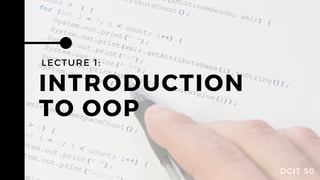Lecture_1___Introduction_to_OOP.pdf.pdf
•
0 likes•15 views
introduction to object oriented programming
Report
Share
Report
Share
Download to read offline

Recommended
More Related Content
Similar to Lecture_1___Introduction_to_OOP.pdf.pdf
Similar to Lecture_1___Introduction_to_OOP.pdf.pdf (20)
Oops concepts || Object Oriented Programming Concepts in Java

Oops concepts || Object Oriented Programming Concepts in Java
More from AngelaClarito1
More from AngelaClarito1 (7)
Recently uploaded
Recently uploaded (20)
Apidays New York 2024 - Accelerating FinTech Innovation by Vasa Krishnan, Fin...

Apidays New York 2024 - Accelerating FinTech Innovation by Vasa Krishnan, Fin...
Apidays New York 2024 - The value of a flexible API Management solution for O...

Apidays New York 2024 - The value of a flexible API Management solution for O...
Web Form Automation for Bonterra Impact Management (fka Social Solutions Apri...

Web Form Automation for Bonterra Impact Management (fka Social Solutions Apri...
Apidays New York 2024 - Scaling API-first by Ian Reasor and Radu Cotescu, Adobe

Apidays New York 2024 - Scaling API-first by Ian Reasor and Radu Cotescu, Adobe
CNIC Information System with Pakdata Cf In Pakistan

CNIC Information System with Pakdata Cf In Pakistan
Spring Boot vs Quarkus the ultimate battle - DevoxxUK

Spring Boot vs Quarkus the ultimate battle - DevoxxUK
Cloud Frontiers: A Deep Dive into Serverless Spatial Data and FME

Cloud Frontiers: A Deep Dive into Serverless Spatial Data and FME
Six Myths about Ontologies: The Basics of Formal Ontology

Six Myths about Ontologies: The Basics of Formal Ontology
ICT role in 21st century education and its challenges

ICT role in 21st century education and its challenges
Polkadot JAM Slides - Token2049 - By Dr. Gavin Wood

Polkadot JAM Slides - Token2049 - By Dr. Gavin Wood
EMPOWERMENT TECHNOLOGY GRADE 11 QUARTER 2 REVIEWER

EMPOWERMENT TECHNOLOGY GRADE 11 QUARTER 2 REVIEWER
Cloud Frontiers: A Deep Dive into Serverless Spatial Data and FME

Cloud Frontiers: A Deep Dive into Serverless Spatial Data and FME
Apidays New York 2024 - APIs in 2030: The Risk of Technological Sleepwalk by ...

Apidays New York 2024 - APIs in 2030: The Risk of Technological Sleepwalk by ...
Apidays New York 2024 - The Good, the Bad and the Governed by David O'Neill, ...

Apidays New York 2024 - The Good, the Bad and the Governed by David O'Neill, ...
Introduction to Multilingual Retrieval Augmented Generation (RAG)

Introduction to Multilingual Retrieval Augmented Generation (RAG)
Strategize a Smooth Tenant-to-tenant Migration and Copilot Takeoff

Strategize a Smooth Tenant-to-tenant Migration and Copilot Takeoff
Lecture_1___Introduction_to_OOP.pdf.pdf
- 2. TOPIC AND SCOPE: Programming Paradigm The 6 key concepts of OOP LEARNING OBJECTIVE: to understand and have an overview of the course and java in object oriented programming
- 3. PROGRAMMING PARADIGM Programming Paradigm is how you write or organize your codes. It’s not always the syntax part but it is how you structure your code.
- 5. PROCEDURAL PROGRAMMING is a style of programming in which the problem is broken down into a series called procedures. In this type of programming, you are writing a sequential series of execution steps/tasks. The code execution is “Top to Bottom” and you do not organize your code logically, but instead you just execute steps after steps.
- 7. OBJECT-ORIENTED PROGRAMMING Object-Oriented Programming breaks down a programming task into a series of entities or objects. You will organize your data and logic in objects, ‘real world’ objects.
- 12. OBJECT-ORIENTED PROGRAMMING OOP is a type of programming in which programmers define not only the data structures , but also the types of operations (methods) that can be applied to the data structure. One of the advantages of using OOP as your programming paradigm is code reusability. OOP enables programmers to create modules that do not need to be changed when a new type of object is added.
- 13. Objects Data Encapsulation Public Interface Class Inheritance Polymorphism THE 6 KEY CONCEPTS OF OOP
- 14. OBJECTS Real-world objects share two characteristics − They all have state and behavior. An object stores its information in attributes and discloses its behavior through methods.
- 15. A class is a group of objects that has mutual methods. It can be considered as the blueprint using which objects are created. Classes being passive do not communicate with each other but are used to instantiate objects that interact with each other. CLASS
- 16. To explain the concept of class and objects, take a look at the diagram below: We have here a class named ‘Mobile Phones’, we also have brands of mobile phones such as Iphone, Samsung and Xiaomi. These three brands are the objects from the class ‘Mobile Phones’. Attributes are basically the variables in programming while methods are obviously the skills or things that it can do.
- 17. Hiding the implementation details of the class from the user through an object’s methods is known as data encapsulation. In object oriented programming, it binds the code and the data together and keeps them safe from outside interference. DATA ENCAPSULATION
- 18. The point where the software entities interact with each other either in a single computer or in a network is known as pubic interface. This help in data security. PUBLIC INTERFACE
- 19. INHERITANCE Inheritance as in general terms is the process of acquiring properties. In OOP one object inherit the properties of another object.
- 20. POLYMORPHISM Polymorphism is the process of using same method name by multiple classes and redefines methods for the derived classes.
- 21. HISTORY OF JAVA FEATURES OF JAVA ACTIVITY #1 (INFOGRAPHIC) SAMPLE INFORGRAPHIC -> CREATE / DESIGN AN INFOGRAPHIC ABOUT THE FF: